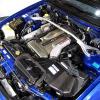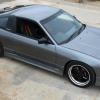Tyre Pressures, And The Argument I Had With A Mate
Announcements
-
Similar Content
-
Latest Posts
-
By robbo_rb180 · Posted
AFM looks to be a z32 The injectors maybe old Nismo 555cc The turbo tag when looked up seems to be a gt2871 , imagine it would have the bigger rear housing .82 all look like the mid 00's mods when he started building it up. Vac hose seems right but would need to see a diagram. Great work going up there and sorting it out, be a good club car for someone wanting a good reliable rig. I know I would like to have it but no space and too many other race cars at the moment. -
Heys guys I got a r32 gtst speedo is out by 10kph seems the faster I go the more it be out just seeing if anyone else had to problem and knows how to fix it
-
I can't agree. If we hadn't all been brought up with the noise caused by the inefficiency of an ICE, no-one would actually ask for all that. An EV is like any other car, it just goes better.
-
2 more things I have to work out Easy one first...can anyone describe how to pull the fuel pump and sender from a 33? I can feel there is some sort of mount and clips but don't have a manual and don't know the trick......if not I'll spend some quality time in the boot witha lighter tomorrow. Second question is harder. He had changed the upper plenum to a plazmaman but clearly got to a point with the vacuum hoses where he said "f**k it, I'm going inside for a beer" and never came back to that job because it was a mess. Am I right to think that I need: 1. Pre throttle (16mm nipple on inlet) to AAC's main 20mm fitting as the main pre throttle feed 2. ACC has a second 13m outlet joined to that 20mm fitting which I think is the pre throttle air supply for the cold start valve? 3. Cold start valve's outlet fitting then goes to Plenum (to bypass throttle?) There is some adapter on the back of the ACC with 2 fittings (13mm and 10mm), do I run the 10mm through a 1 way valve to the Brake Booster (4) and the 13mm back to a 13mm nipple on the Plenum as the Idle control (5)? 6. Run a 6mm vacuum line from the Turbosmart BOV to the Plenum? 7. Run a 5mm vacuum line from the Fuel Pressure Reg to the Plenum? 8. Run a 5mm vacuum line from the Turbosmart Boost controller to the Plenum? (Wastegate already has a pre turbo pressure source running to the solenoid then the wastegate on the other side of the bay) Any help appreciated, the GTR is quite different setup and while the Stagea also has FFP it is different again. (And no Dose, I'm not pissing it all off and putting a ethrottle on it....)
-
OK, onto some questions to try and speed up the process a little. Does anyone know what core this Garret is? I know it is a high flowed standard turbo but nothing else about it. Tag says OK 0169J - 446179-5032 Same question for the injectors, I don't know what they flow and ideally can work it out before it hits the dyno, they are a mustard yellow side feed
-






Recommended Posts
Create an account or sign in to comment
You need to be a member in order to leave a comment
Create an account
Sign up for a new account in our community. It's easy!
Register a new accountSign in
Already have an account? Sign in here.
Sign In Now